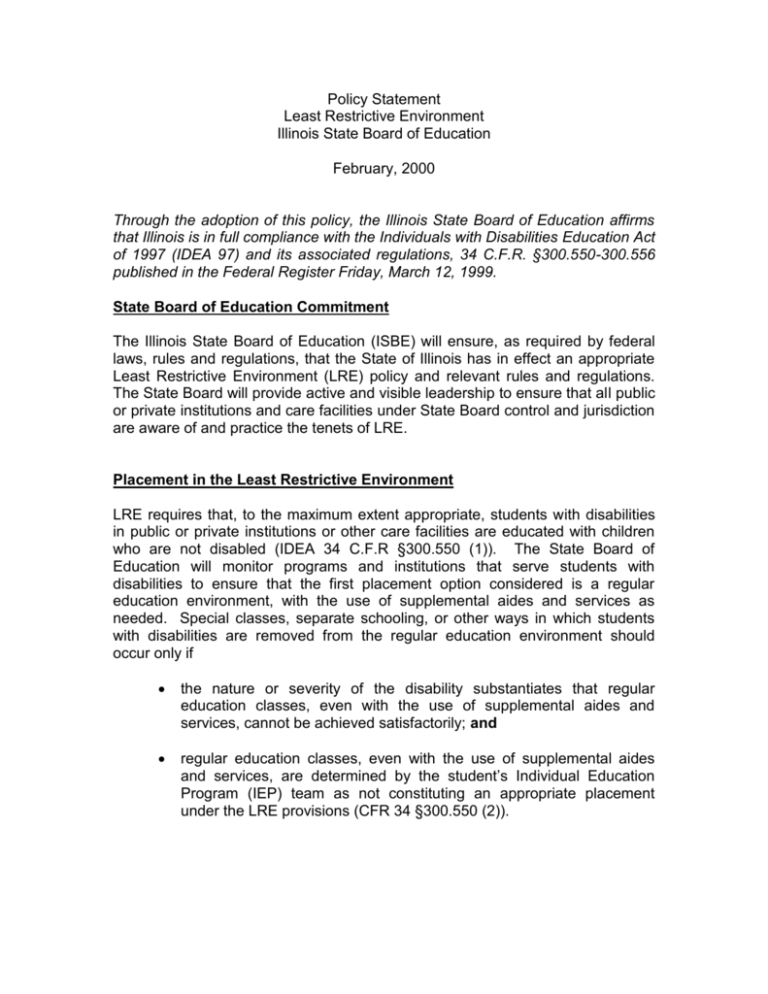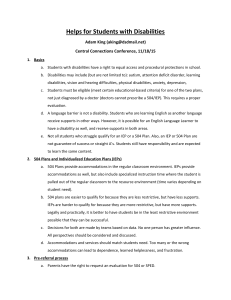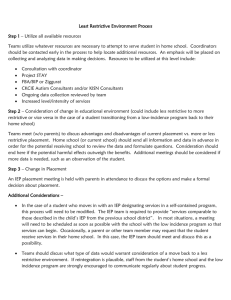Least Restrictive Environment Policy Statement
advertisement

Policy Statement Least Restrictive Environment Illinois State Board of Education February, 2000 Through the adoption of this policy, the Illinois State Board of Education affirms that Illinois is in full compliance with the Individuals with Disabilities Education Act of 1997 (IDEA 97) and its associated regulations, 34 C.F.R. §300.550-300.556 published in the Federal Register Friday, March 12, 1999. State Board of Education Commitment The Illinois State Board of Education (ISBE) will ensure, as required by federal laws, rules and regulations, that the State of Illinois has in effect an appropriate Least Restrictive Environment (LRE) policy and relevant rules and regulations. The State Board will provide active and visible leadership to ensure that all public or private institutions and care facilities under State Board control and jurisdiction are aware of and practice the tenets of LRE. Placement in the Least Restrictive Environment LRE requires that, to the maximum extent appropriate, students with disabilities in public or private institutions or other care facilities are educated with children who are not disabled (IDEA 34 C.F.R §300.550 (1)). The State Board of Education will monitor programs and institutions that serve students with disabilities to ensure that the first placement option considered is a regular education environment, with the use of supplemental aides and services as needed. Special classes, separate schooling, or other ways in which students with disabilities are removed from the regular education environment should occur only if the nature or severity of the disability substantiates that regular education classes, even with the use of supplemental aides and services, cannot be achieved satisfactorily; and regular education classes, even with the use of supplemental aides and services, are determined by the student’s Individual Education Program (IEP) team as not constituting an appropriate placement under the LRE provisions (CFR 34 §300.550 (2)). Continuum of Alternative Placements Each responsible public or private agency must provide assurances to the State Board of Education that a full continuum of alternative placements is available to address the needs of students with disabilities and ensure that those students receive special education and related services appropriate to their needs. The continuum of alternative placements must provide the IEP team with a wide spectrum of options and locations for serving students with disabilities. The continuum must include instruction in regular classes, with or without supplementary aides and services; pull-out programs for part of the day, with the remainder of the student’s day spent in the regular education classroom or in activities with students who do not have disabilities; self-contained special education classes within the student’s neighborhood school; self-contained classes in another regular education school, or in a non-public or special purpose school; home instruction; and instruction in hospitals and institutions, including residential placement opportunities (IDEA 34 C.F.R §300.26). The IEP team must base its placement decision solely on the identified needs of each student with a disability. However, the team must always give first consideration to placement in the regular education classroom and it must be able to justify each subsequent, increasingly restrictive option in terms of the least restrictive environment provisions and the needs of the student. Placements Each public or appropriate private agency that determines educational placement for students with disabilities, including preschool-age children, must assure the State Board of Education that Decisions about the placement of students with disabilities are made by a group of persons, including the parents and other knowledgeable persons, who will review and evaluate relevant data and consider placement options appropriate to each student’s specific identified needs. All placement decisions conform to the LRE provisions referenced in state and federal laws, rules and associated regulations. All placements of students with disabilities are determined at least annually. All placements are based on the identified needs of individual students with disabilities, as documented in their respective IEP. All placements are located as close to the student’s home as possible. First consideration is given to the school the student would attend if not disabled and other placements are considered only if the IEP team determines that the student’s needs require a different location to ensure free appropriate public education in the least restrictive environment. In determining the least restrictive environment, the IEP team considers any potential harmful effects on the student with a disability or on the quality of services required. In determining the least restrictive environment, the IEP team also considers any potential harmful effects on other students. Decisions reflect the following interpretation related to Section 504 of the Federal Rehabilitation Act: “Where a handicapped child is so disruptive in a regular classroom that education of other students is significantly impaired, the needs of the handicapped child cannot be met in that environment. Therefore, regular placement would not be appropriate to his or her needs.” (34 C.F.R. §300.552 and Section 504 of the Rehabilitation Act Section 34 C.F.R part 104Appendix, Paragraph 24). The IEP team uses extreme caution when determining the least restrictive environment in such circumstances and provides full documentation and justification of its decision. No students with disabilities are removed from placement in an ageappropriate regular classroom solely because modifications are required in the general education curriculum or for administrative convenience. To the maximum extent appropriate, students with disabilities are involved in the regular education curriculum and their progress is determined and recorded by the IEP team. Each student’s IEP states whether the student will participate in state and/or local district assessments and whether any modifications or accommodations are appropriate and necessary if the student participates fully or in part. If the student with a disability is excluded from these assessments, the IEP team describes what alternate assessment techniques will be used and how scores will be integrated and reported (34 CFR 300.138-300.139). Nonacademic Settings IDEA 97 does not require school districts to provide nonacademic services and extracurricular activities solely for children with disabilities. However, school districts and other agencies serving students with disabilities must ensure that those students have an equal opportunity to participate in such activities when determined appropriate by the IEP team (Section 504 34 C.F.R. §104.37 (a)(1)). When the district or appropriate private agency does provide for or arrange nonacademic and extracurricular services/activities appropriate for a student with disabilities, the IEP team must determine the required supplementary aides and services necessary for participation. Nonacademic and extracurricular services/activities may include athletics, transportation, health services, recreational activities, special interest groups, meals, recess periods, counseling services, referrals to agencies that provide assistance to individuals with disabilities, and employment of students, including both employment by the public or appropriate private agency and assistance in making outside employment available. Children in Public or Private Institutions To ensure that students with disabilities are educated in the least restrictive environment and receive a free, appropriate public education at no expense to their parents, the State Board of Education will forge agreements with appropriate public and private institutions and associated state agencies (IDEA regulation 34 C.F.R §300.550), except as provided for in IDEA regulation 34 C.F.R §300.600 (d) Technical Assistance and Training The State Board of Education will ensure that teachers and administrators in all public and appropriate private agencies that deal with students with disabilities are fully informed about their responsibilities for implementing IDEA 97 and meeting the least restrictive environment requirements. This will include providing clear and sufficient guidelines and other information needed by educators and parents. The State Board will also provide technical support and assistance to public and private agencies, including necessary training and retraining to ensure that LRE is systematically provided. Monitoring Activities The State Board of Education will monitor each public and appropriate private agency identified as serving students with disabilities to ensure that the Least Restrictive Environment requirements are being implemented. If the Board discovers evidence that placements inconsistent with the LRE are being made, staff will review the public or private agency’s justification and then help the agency plan and implement the corrective action necessary to comply with LRE. Conclusion Schools have been required to provide students with disabilities a free appropriate public education in the least restrictive environment since 1975, when the federal Education for all Handicapped Children Act was first adopted. Despite this 25-year history, gaining a full understanding of LRE can be perplexing and at times elusive, because LRE differs for each student with a disability and the special education and related services he or she receives. In addition, the least restrictive environment is not always simple to determine and at times may appear to be in conflict with FAPE. Fortunately, case law standards have been set that “assist schools in determining if they have met the FAPE and LRE mandates” (Yell, 1995). In the most simple terms, LRE is the environment where the student can receive an appropriate public education designed to meet his or her special education needs, while still being educated with non-disabled peers to the maximum extent appropriate. The least restrictive environment focus of IDEA 97 does not look at “why” students with disabilities should be educated with students who do not have disabilities, but “why not.” ISBE is committed to this LRE focus and will encourage and assist school districts and other public and private agencies to maintain this vision in their placement decisions.







